8 Best Companion Plants for Lavender (With Pictures)
-
- Last updated:
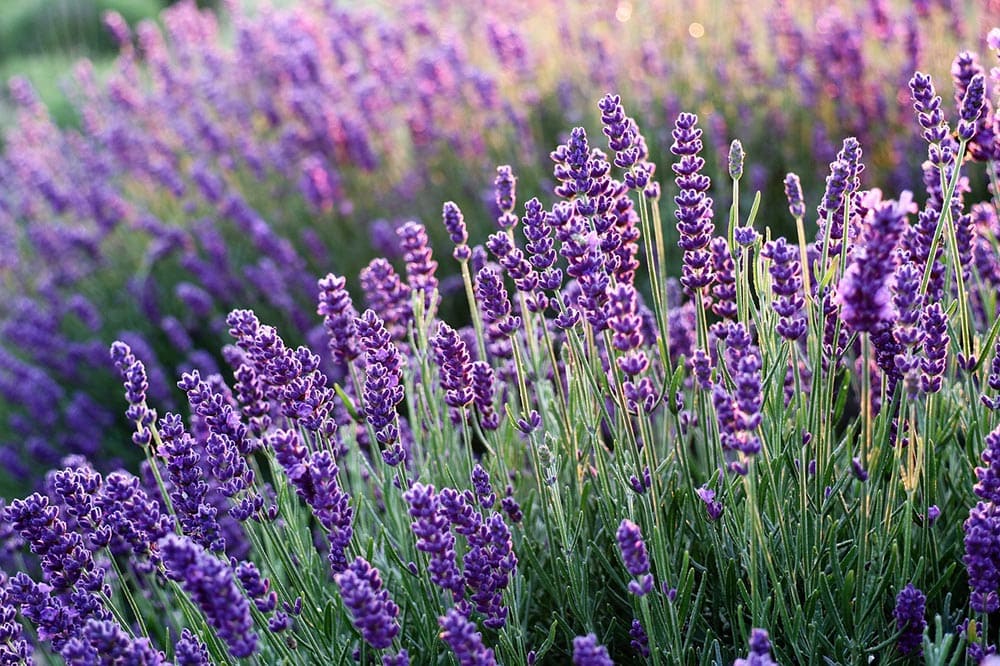
Lavender is a popular plant that can be found around the country. Lavender flowers have a delicate shade of purple that blends well with many other colors. Lavender also smells amazing and can be used as an additive to things like creams or soaps. On its own, lavender can look a little underwhelming. It can be thin and small, especially compared to larger and more vibrant plants. That makes lavender a great candidate for companion plants.
Companion plants are added to help enhance or compliment lavender by adding more volume, color, or texture to your garden. However, not all plants make good companions for lavender. Lavender needs a particular environment to thrive that is not conducive to all plants.
Here are eight great companion plants for lavender and four that you are going to want to avoid.

The 8 Best Companion Plants for Lavender
1. Roses

| Scientific Name: | Rosas |
| Why They’re a Good Fit: | Perfect visual contrast for lavender |
Roses are one of the most iconic flowers in the world. Roses also happen to be a perfect companion for lavender. In gardens, especially English gardens, roses and lavender have been paired together for decades. Both roses and lavender have similar needs in terms of soil composition and water consumption. The purple color of the lavender perfectly contrasts the pinks, reds, and whites of common roses. If you intend to plant roses with your lavender, be sure to build in some natural separation between them. Roses tend to grow outward and are larger than lavender, and you don’t want your roses to choke out your lavender accidentally.
2. Zinnias

| Scientific Name: | Zinnia elegans |
| Why They’re a Good Fit: | Can survive in warm, dry conditions like lavender |
Zinnias are some of the easiest flowers to grow. Zinnias come in many different colors, shapes, and sizes. Zinnias are a great companion for lavender because they can survive in warm and dry conditions, similar to lavender. Zinnias are great flowers for novice gardeners or young gardeners since they will offer great color without the risk of dying off too quickly. Zinnias and lavender are hard to kill, and they make great hardy plants that are easy to care for and easy to keep in bloom.
3. Echinacea
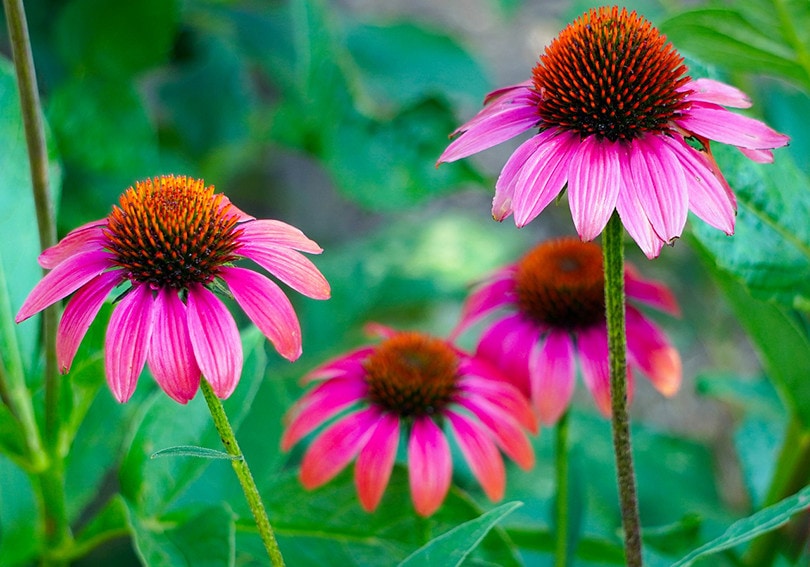
| Scientific Name: | Echinacea purpurea |
| Why They’re a Good Fit: | Requires even less water than lavender, great visual pair |
Echinacea, or cone flowers, are a natural fit for lavender. Echinacea produces beautiful purple flowers that are a different shade and shape from that of lavender. Coneflowers are very durable plants that require lots of sun and very little water. In fact, echinacea flowers are some of the most drought-tolerant flowers available. The dry soil, drought tolerance, and sunlight requirements make them a natural partner for lavender. Both of these plants can survive on little water and thrive in full sun. They also look great together. As long as you don’t overwater your lavender, you won’t have any issues keeping your echinacea alive in the same area.
4. Sage
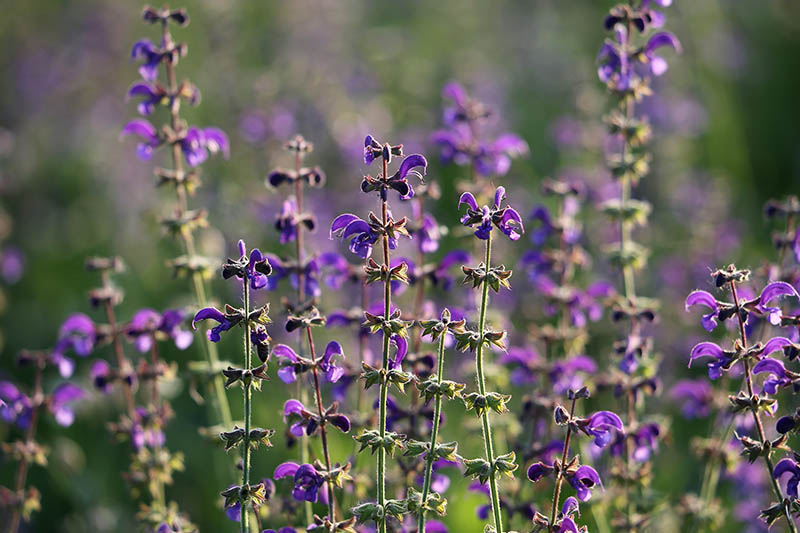
| Scientific Name: | Salvia officinalis |
| Why They’re a Good Fit: | Adaptable perennial will thrive next to lavender |
Sage is a highly adaptable and hardy perennial herb that grows year-round. Sage is very easy to keep alive and very easy to help thrive. The bright purple flowers found on sage also make a great color complement to lavender’s pale purple coloring. Sage, like lavender, likes full sunlight and moderate amounts of water. Sage is a popular herb that is used in many ways. Sage is different from other herbs because the leaves retain their flavor even as they grow larger and more mature. Sage can also deter pests with its scent and can keep harmful insects away from your nearby lavender plants.
5. Oregano

| Scientific Name: | Origanum vulgare |
| Why They’re a Good Fit: | Attracts bees for lavender |
Oregano is a popular herb that is used in the kitchen for a variety of different seasoning needs. Oregano also makes a perfect companion plant for lavender. Like lavender, oregano enjoys full, hot sun, and dry soil. In addition to that, oregano is aromatic and attracts beneficial bees. Lavender does not always attract many bees on its own, but oregano will draw in pollinating insects which can help your lavender grow, propagate, and thrive. Oregano is also a short, ground-covering plant that can create a pleasing boundary around your lavender. These things make oregano a natural companion for lavender that adds utility and visual functionality.
6. Thyme

| Scientific Name: | Thymus vulgaris |
| Why They’re a Good Fit: | Hail from the same environment |
Thyme is a plant that comes from the rugged hills of the Mediterranean, the same environment that lavender comes from and thrives in. That means these two plants will have very similar care requirements. Thyme also likes sandy soil, moderate water, and warm temperatures. Thyme can grow in more temperate climates than other Mediterranean plants. You can grow it in USDA zones 5-9, giving it some cold tolerance. Thyme can survive through the winter if it is given proper care, and it will come back in the spring. Thyme is also a nice contrast for lavender as it is more of a ground-covering plant as opposed to lavender’s vertical stalks.
7. Alliums
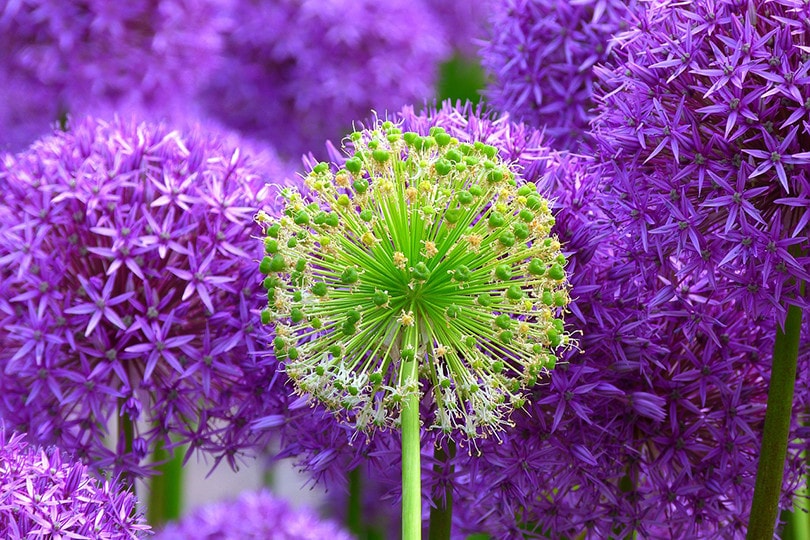
| Scientific Name: | Allium |
| Why They’re a Good Fit: | Great visual contrast |
Alliums are a family of plants that include things like onions, shallots, and chives. However, when cultivated for personal gardens, alliums produce interesting purple flowers. Alliums grow flowers atop tall stalks and can produce truly vibrant spheres of blooms. Alliums create a great contrast to lavender. Lavender is generally short and modest, while alliums are tall and ostentatious. Alliums also have the same care requirements as lavender. Alliums like sandy soil, moderate water, and full sun. That means you can create some nice visuals by using tall alliums and short lavender in the same pot or bed.
8. Rosemary
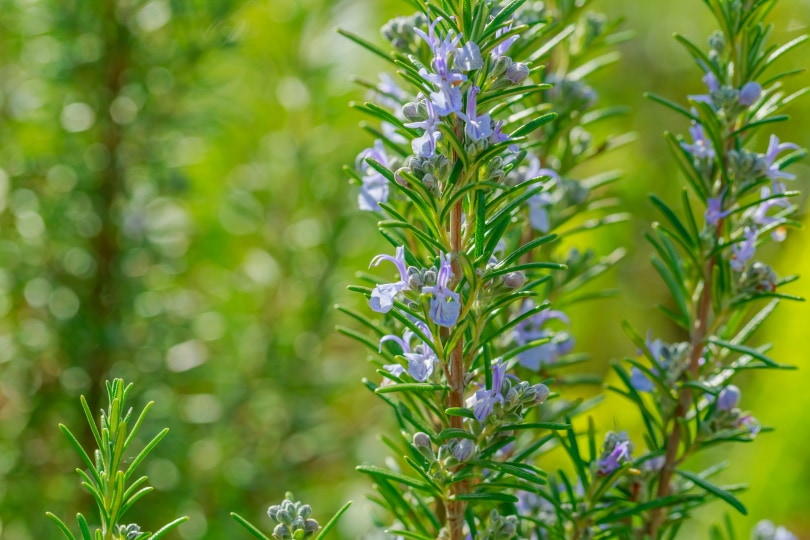
| Scientific Name: | Salvia rosmarinus |
| Why They’re a Good Fit: | Comes from the same environment as lavender |
Rosemary shares a lot of traits with lavender. Both plants hail from the same Mediterranean regions of the planet. Both lavender and rosemary thrive in full sun, rocky, well-draining soil, and have minimal to moderate water consumption. The shared environment and needs mean you can plant lavender and rosemary together in the same pot or plot, and they will require the exact same type of care. Lavender adds a lot of fragrance and color, while rosemary can be used as an herb for cooking. This pair creates a useful and visually appealing combination that is hard to match.

What Lavender Needs to Thrive
- Full Sun
- Well drained soil
- Dry to moist soil (not wet or soggy)
- Moderate water
The 4 Worst Companion Plants for Lavender
1. Mint

| Scientific Name: | Mentha |
| Why They’re a Good Fit: | Requires too much water |
Mint is an extremely popular herb to grow. Mint smells good, it is easy to cultivate, and it has a lot of medicinal uses. In fact, mint has been grown by humans for thousands of years. Unfortunately, you cannot successfully grow mint and lavender together. Mint requires moist and loose soil that is contrary to what lavender needs. The water requirements of mint are much higher than that of lavender. Mint generally likes cool and moist environments compared to the warm and dry Mediterranean climates where lavender thrives. If you plant mint and lavender together, one will either get too much water or not enough water, leading to poor results.
2. Impatiens
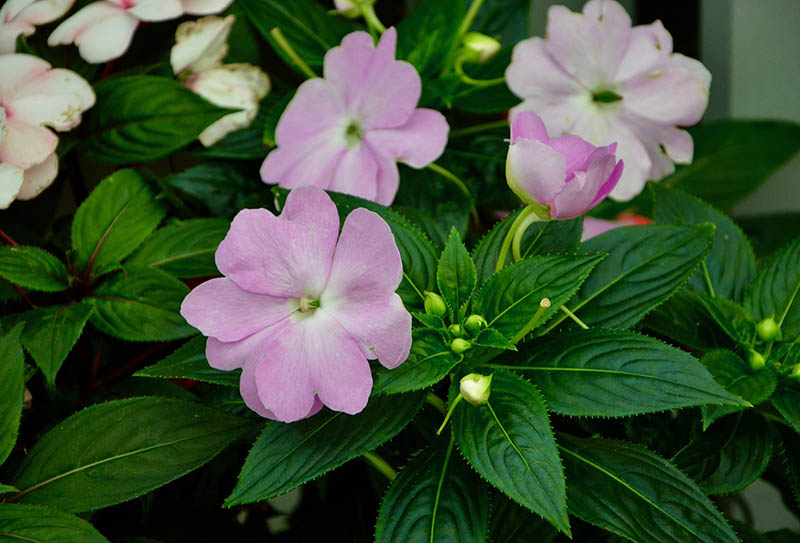
| Scientific Name: | Impatiens |
| Why They’re a Good Fit: | They require full shade, no exceptions |
Impatiens, also called touch-me-nots or impatiens, are a type of flowering plant prized for its blooms. Impatiens have the potential to create large numbers of colorful flowers that visually pair well with lavender. The issue is that impatiens require full shade to survive. If you plant impatiens in full sun, they will wither and die. If you plant lavender in full shade, it will not thrive. Lavender planted in the shade might survive, but it will likely never bloom, which eliminates the point of planting lavender in the first place. The opposite sun requirements mean that these two plants cannot be planted anywhere near one another.
3. Camellias
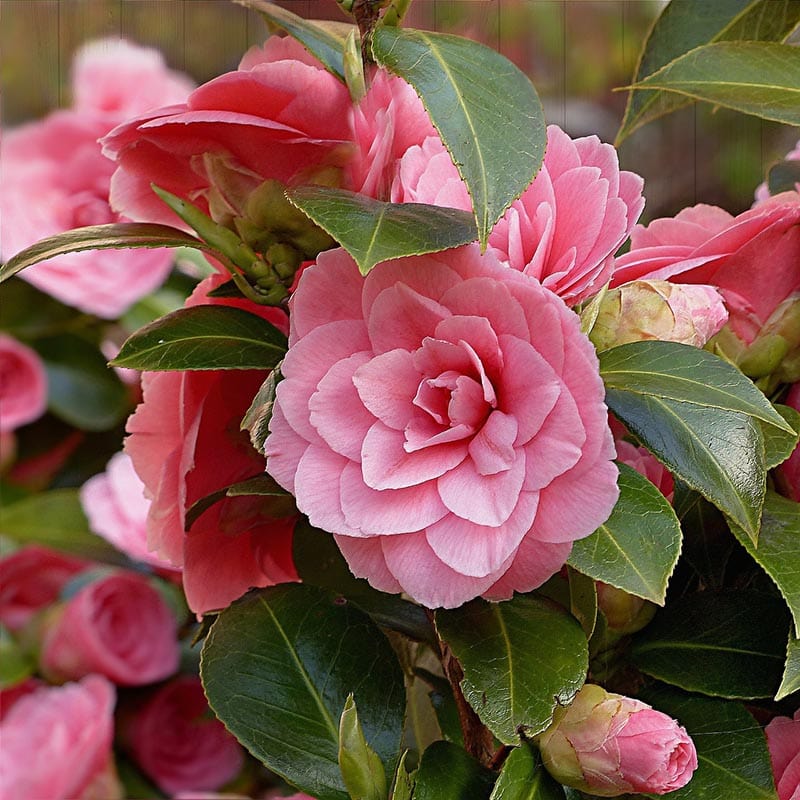
| Scientific Name: | Camellia |
| Why They’re a Good Fit: | Differing water needs |
Camellias are a very popular type of flower found in gardens across the country. At first glance, it might seem like camellias and lavender might be compatible. They both thrive in USDA growing zones 7-9 and are relatively easy to keep alive. However, camellias need a lot more water than lavender. Camellias enjoy frequent watering and wet soil. Lavender does best with moderate watering and dry, draining soil. Camellias need much more water than lavender, meaning if you try and plant them close to one another, you will end up overwatering your lavender in order to get your camellias to bloom. If you overwater lavender, the roots will rot, and the plant will eventually die.
4. Hostas
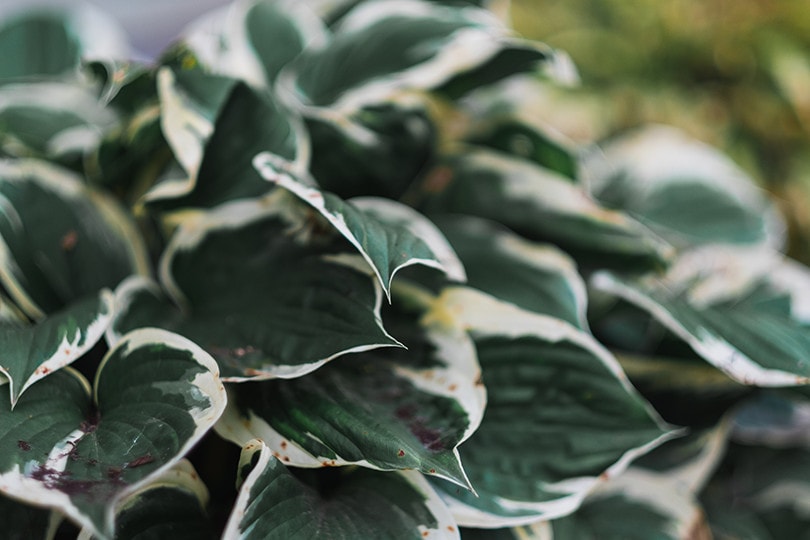
| Scientific Name: | Hosta |
| Why They’re a Good Fit: | Completely different sunlight needs |
Hostas are a popular perennial plant with striking green leaves and generous care requirements. Hostas are easy to keep alive and grow into large and eye-catching shrub-like plants. Unlike lavender, hostas need dappled light, partial shade, or full shade to survive. Remember that lavender needs full sun to thrive. If you plant hostas in full sun, they will wither, get sunburned, and eventually dry out and die. For that reason, these two favorites cannot live together peacefully.

Conclusion
Lavender is a great plant beloved by many for its fragrance and appearance. Lavender pairs well with a number of plants. Some plants share the exact same needs as lavender making them a natural fit, while other plants offer some visual contrasts or utility to lavender. Any one of these eight plants would be a great companion for your lavender. Just be sure to avoid the four unsuitable options. Planting an unsuitable companion near your lavender will cause problems for your lavender or your companion plant.
Featured Image Credit: Mouse23, Pixabay
Contents

